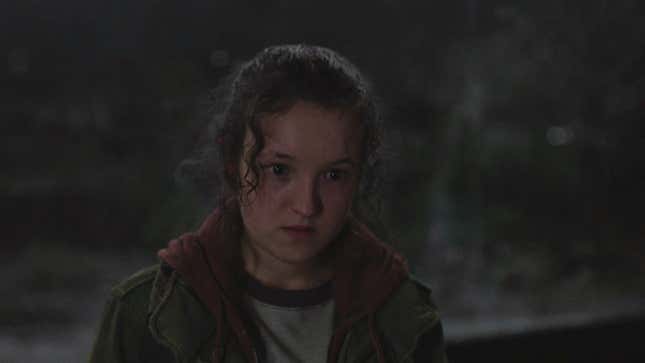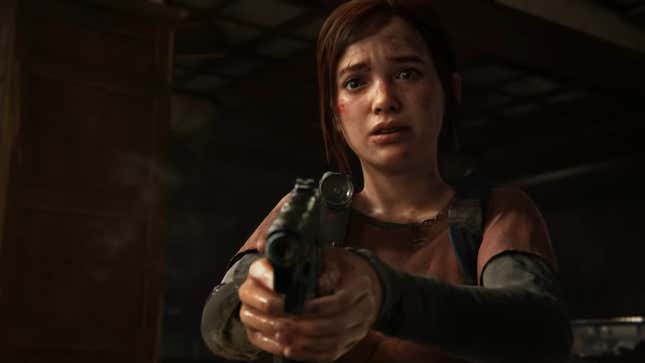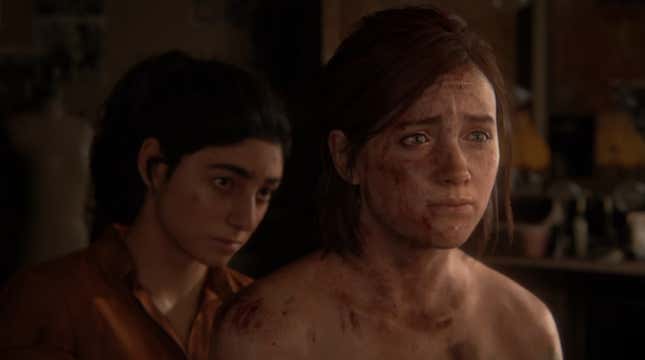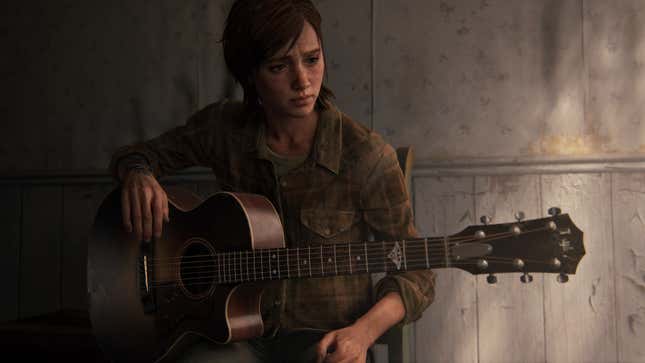The following contains spoilers for The Last of Us show and both games.
Inevitably, someone will read everything I write here and chalk it up to “being mad about the show doing something different from the games,” but reader, I implore you to consider that just because something is different, that doesn’t mean it is inherently good or above critique. I’ve got beef with the version of Ellie in HBO’s The Last of Us show. The show has constantly been oscillating between big swings and faithful recreations, and some of its departures from the game have certainly been for the better. But certain scenes, dialogue, and even behind-the-scenes discussions surrounding the character of Ellie are leaning into a narrative that I think already does her journey through violent grief a huge disservice and we haven’t even seen it through, yet.
To get it out of the way, none of this is on Bella Ramsey, who portrays the young girl in the adaptation. She’s doing an excellent job with the material she’s been given, and it’s been a truly refreshing experience in even the most faithfully recreated scenes to see Ellie played by a teenager. Ashley Johnson’s performance in the game still captured the character’s youth, but it had the polish of an adult playing a child character. No, my beef is with showrunners Craig Mazin and Neil Druckmann, who are leaning harder toward a narrative suggested by The Last of Us’ marketing, rather than the one that plays out in the games themselves. I’m specifically referring to how the show frames Ellie’s relationship with violence, and how it portrays her not as a child who had to learn how to fight to protect herself and the ones she cares about, but as the post-apocalyptic equivalent of a kid who kills animals in their backyard for fun.
The showrunners say Ellie is “activated” by and likes violence in the show
Initially, I didn’t pick up what Mazin and Druckmann were putting down when I first watched the series’ premiere episode. In the final scene of the episode, Ellie witnesses a brutal murder of a FEDRA soldier at the hands of Joel, played by Pedro Pascal. She watches in what I initially read as shock, but as Mazin describes it in the Inside the Episode video for the pilot (skip to about the 4:30 mark), this isn’t a stunned silence. It’s her being “activated.” She “likes” watching the violence unfold. She likes the idea of being defended to brutal ends, and the idea of this dude getting “punished” for the indiscretion of holding them at gunpoint.

Perhaps, at the time, I read her silence as shock because of my familiarity with the game, where she repeatedly expresses shock and discomfort early on at the lengths Joel must go to to keep them alive. But the framing of Ellie as a person who actively likes violence rather than one who turns to it out of necessity has become much more apparent throughout the season’s run. Episode three, which is otherwise a beautiful story about how violence is sometimes the end result of loving and protecting someone in the post-apocalypse, has a scene where Ellie finds an infected pinned down by a bunch of rubble. Rather than dealing with it efficiently and getting back to business, Ellie takes her time to hover over the poor bastard and look him over like he’s a dying animal. She slices open his head with her switchblade and sees what’s under the skin of an infected. When she finally stabs him in the head and kills him, she pulls back with a satisfied expression that’s unnerving. Again, Ramsey is putting in the work here.
G/O Media may get a commission
Joel never sees this scene unfold, because it’s important that he views her as an innocent kid and not a weird, violence-loving pervert, but, horrifyingly enough, the character who does see this side of her is David, the predatory, cannibalistic cult leader she meets in the series’ eighth episode. When he’s got her caged up in his cannibal kitchen, he says he can’t let her out because she would take her switchblade and gut him. Which, like, you’re a cannibal who kidnapped her, so spare us the judgment when she naturally wants to kill someone who abducted her. But he goes on to say she has a “violent heart.” Which, unfortunately, I guess is true in this version of the character. All of this might be different after the events of episode eight, but we spend so much time engaging with Joel’s violent actions in the season finale that it’s not clear where Ellie stands now.
The reason this doesn’t sit well with me is because it’s not only fundamentally at odds with Ellie’s story in the game, but because it feels like it’s rooted in a simplistic and reductive view of her story in the source material, a view that was largely perpetuated by Naughty Dog in its own marketing campaign for The Last of Us Part II.
What is Ellie’s relationship with violence in the games?
Let’s rewind to the beginning of Ellie’s story in the game. When she and Joel first meet, she’s not had a ton of exposure to violence. At least, not the kind of human brutality Joel would expose her to throughout the first game. When Joel kills the FEDRA forces there, Ellie is taken aback, having thought they would just hold them up as they made their escape. Eventually, Ellie comes to accept the necessity of this violence as they make their cross-country journey, leading to her first kill in order to save Joel from a raider. She’s sick about it, and it results in tension between her and Joel because she picked up a gun despite his deliberately never giving her one. The two then bond over him teaching her how to use a rifle and then giving her a pistol. It’s a point of newfound trust, and it illustrates that Ellie takes on violence for necessity’s sake.

The equivalent scene in the show is a painfully drawn-out sequence where Ellie shoots a raider in the leg and while he pleads for his life, Joel tells her to get to safety while he handles it. Then the two jump right into talking about the effects killing can have on your soul. In an abstract way, this feels like it’s setting up Part II’s themes in a more overt way, which has been a running theme throughout the season. We can see the show pretty deliberately leading into the events of the sequel for season two with a number of things, including references to characters like Dina and framing Joel’s actions in a sympathetic way. Part II sees Ellie going down a dark, violent path, so perhaps the thinking here is that by asserting Ellie is a violent person, the things she does later will seem more consistent with our understanding of her character. But the foundation of Ellie’s relationship with violence is fundamentally different, and I don’t think it’s for the better when, in the games, the contrast between who Ellie was and who she became is so fundamental to her story.
Part of what makes The Last of Us Part II effective is that it feels like a transformative story for Ellie. She’s gone from a child who was horrified by Joel’s violence to a young adult who travels to Seattle in the grip of righteous fury. She goes on this crusade to find a group who killed Joel and at least kill Abby, the one who dealt the killing blow. She goes under the pretense that this is what she wants to do, but as she goes on her revenge tour, each subsequent kill wears on her.
The death of Nora, which is a loaded scene for a lot of reasons, is where this starts to become clear. Ellie commits one of her most heinous acts of violence in the game during an interrogation, and in the next scene, she’s overwhelmed with guilt at the lengths she had to go to. She has to be comforted by Dina, afraid her partner will see a monster where she once saw a future. Next, in an attempt to extort information about Abby’s whereabouts from her friends Mel and Owen, she tries to use Joel’s signature interrogation technique of asking one party for information and confirming with the second. If the information matches up, she knows it’s accurate. If not, well, that’s up to her discretion. But despite her attempts, the confrontation goes off the rails and ends with Ellie killing both of them in a messy scrap. She then realizes Mel was pregnant, and is immediately overcome with anxiety at having killed an innocent party. Throuhgout her spiral into violence, Ellie is repeatedly confronted with the possibility that she’s not cut out for what she signed on for.

Eventually, she leaves Seattle without killing Abby. The fact that she killed everyone other than the person she views as most responsible for Joel’s death wears on her, but Dina is growing sick from her own pregnancy, and everyone around her is telling her this is the best course of action. They argue that Abby losing those close to her is an equivalent punishment for taking the life of Joel. She reluctantly goes along with the plan, up until Abby shows up at their hideout and forces her to go along with the plan by way of a beatdown and a threat.
After this, Ellie tries to live a normal life in the post-apocalypse by living on a farm with Dina and their son JJ. But she’s still dealing with PTSD surrounding the death of Joel, and ultimately leaves her family behind to pursue Abby once more. Once she tracks her down to Santa Barbara, California, the two come to blows one more time. Ellie gets the upper hand and nearly drowns her on the California beach. But in a moment of clarity, she lets Abby go, realizing this was never going to bring her the peace she wanted.
What does violence actually mean in The Last of Us?
Whether driven by survival or grief, The Last of Us has never framed violence as something characters take an overt pleasure in. Sure, when Ellie kills Jordan—who was a snarky piece of shit—in Part II, it’s satisfying to fuck him up. But it has an underlying meaning beyond Ellie liking acts of carnage. The fact that she has gone through a fair bit of the series uncomfortable or traumatized by violence makes her giving into it a moment of noticeable change, and her repeated struggle to persevere in her quest illustrates that despite her compulsion, this isn’t who she is.
Meanwhile, the showrunners are over here telling us that this is absolutely who Ellie is. It’s alluding to a version of this story that feels more in line with Naughty Dog’s marketing of The Last of Us Part II than it does the story it actually told. As a person who found Ellie (and Joel and Abby, for that matter) profoundly sympathetic by the end of the sequel, it’s worrisome to me that HBO’s version of her is leaning into a perverse vision of what violence means in The Last of Us.
Unfortunately, Part II’s marketing campaign lost the thread of grief and love-driven violence that’s at the core of the game and swaths of the internet think The Last of Us is about how violence is bad, and players should feel bad for doing it. How did this interpretation become so prominent? Naughty Dog itself said this is what the game is about. In an interview with Launcher, series director Neil Druckmann described the dueling protagonist structure as having been at least partially inspired by his witnessing of an Israeli soldier’s lynching (there’s an argument to be made that centrist Israeli politics run through the game’s veins), and a desire he felt to hurt those responsible. This was followed by immense guilt and a desire to explore that idea in Part II’s structure. The idea is that you would play through Ellie’s segments killing Abby’s friends, then find out at the end that Abby killed Joel in her own grief.
I don’t think it’s wrong to be judgemental of Joel, Ellie, or Abby’s actions. The game itself is pretty overtly critical of them throughout. Ellie’s killing of Abby’s friends is always treated as something that comes with a cost, as nearly every kill she commits is framed as mentally taxing on her. Abby, meanwhile, spends her entire half of the game trying to make up for the way she tortured and killed Joel because she’s trying to “lighten the load.” But nevertheless, we have to act out the play until it reaches its natural conclusion, which leads to the same dissonance we can feel in the first game’s final segment where Joel kills several innocent people to save Ellie.
For characters like Joel and Ellie, violence is a language spoken in a world where they’ve learned and been taught that it’s the only way they can communicate. It’s all the things that the characters feel, that they navigate, that they express through violence (or, in key moments, the choice not to use violence) that really matters. The desire to protect. The desire to avenge. The decision to forgive. But despite Part II delving into themes of grief and forgiveness through violence, the narrative that this series is about violence permeates through how we talk about it. That’s on Naughty Dog because that was the message the studio put out. But I find everything the company said about the game in marketing materials and interviews, such as the assertion that the game was “about hate” when it was first revealed, suspect after it became clear the studio had been deliberately obfuscating what Part II actually was. I understand this was done in an effort to keep the shocking event that sets the game in motion hidden ahead of launch, but the second Joel died instead of showing up in scenes the trailers showed, I approached the game with no further preconceptions.

The sanding down of The Last of Us’ thematic makeup is Naughty Dog’s own doing, but that framing was what people had to work with. Much of the criticism surrounding Part II focuses on its relationship to violence, concluding that it’s meant to be a heavy-handed lesson in the cost of giving in to some base urge to harm one another. In post-release interviews, Druckmann has gone on record saying that the company’s messaging around Part II wasn’t reflective of what the game was actually about. But that’s the video game industry. Companies spend hundreds of millions of dollars to put these games in front of people, and 20+ hour experiences must be reduced to bullet points you can put on marketing copy. It ultimately didn’t affect the prestige of the franchise, as Part II went on to sell 10 million copies and earn countless Game of the Year awards. However, HBO’s television adaptation feels cognizant of the series’ decade of discourse in a lot of ways, and in this case, not for the better.
In some ways, this has worked out in the show’s favor, because stories like Bill and Frank’s get to take on new life as a sign that love is worth living for instead of being a cautionary tale about how caring about people is bad for your self-preservation. But this particular change feels like it’s an odd turn toward a marketing campaign that has ultimately soured a lot of the discussion around The Last of Us and the character at its center. That marketing and the ideas it helped to cement hang over the series to this day. It can be hard to see past those notions when you’re actually playing through a game that, if it is viewed as being about how violence is bad and you should feel bad for doing it, doesn’t hold up to scrutiny. It does hold up, however, when viewed primarily as a story of grief and, ultimately, acceptance. After watching Ellie go through so much inner turmoil as she fought her way through her demons while playing Part II, I don’t understand why the show seems to want us to view violence as something that excites her rather than as something she’ll one day reluctantly resort to as her own pain manifests. Yeah, some people will read this and minimize it to some kind of adaptation purity nonsense. I just hope the core of what The Last of Us is isn’t squandered under what a marketing team said it was to fit all its nuances on the back of a box.

